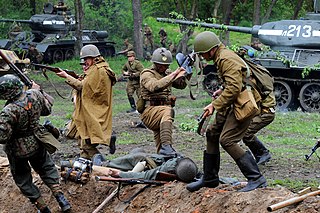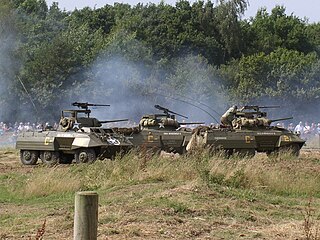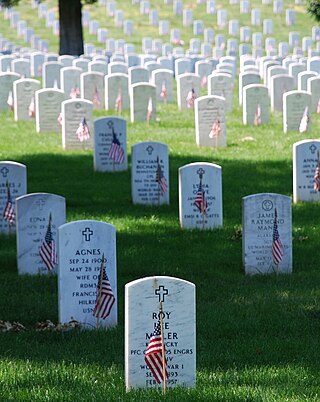
Historical reenactments is an educational or entertainment activity in which mainly amateur hobbyists and history enthusiasts dress in historic uniforms or costumes and follow a plan to recreate aspects of a historical event or period. This may be as narrow as a specific moment from a battle, such as the reenactment of Pickett's Charge presented during the 1913 Gettysburg reunion, or as broad as an entire period, such as Regency reenactment.

Fort Niagara, also known as Old Fort Niagara, is a fortification originally built by New France to protect its interests in North America, specifically control of access between the Niagara River and Lake Ontario, the easternmost of the Great Lakes. The fort is on the river's eastern bank at its mouth on Lake Ontario. Youngstown, New York, later developed nearby.

American Civil War reenactment is an effort to recreate the appearance of a particular battle or other event associated with the American Civil War by hobbyists known as Civil War reenactors, or living historians.

Medieval reenactment is a form of historical reenactment that focuses on re-enacting European history in the period from the fall of Rome to about the end of the 15th century. The second half of this period is often called the Middle Ages. This multiplicity of terms is compounded by the variety of other terms used for the period.

The Battle of Hastings reenactment is a yearly reenactment of the Battle of Hastings, held at Battle Abbey in Battle, East Sussex, UK, and drawing participants from around the world. It takes place every year on the weekend nearest 14 October on the site of the historical battle, although it is often arranged across the hill rather than up it, to take account of the smaller number of participants and the need for spectators.

The Sealed Knot is a British historical association and charity, with many members from outside the United Kingdom, dedicated to costumed reenactment of battles and events surrounding the English Civil War.
In historical reenactment, authenticity is a measure of how close an item, prop, action, weapon, tactic, or custom is to what would actually have been used or done in the time period being depicted. For example, in most northern European medieval reenactment cotton is an inauthentic material—as opposed to wool or linen—though it would be authentic in more modern periods and events, such as American Civil War reenactment or World War II reenactment. Likewise, pop culture references and talking about modern events or objects is inauthentic.

World War II reenactment is the historical reenactment of the various combatants involved in World War II.

Olustee Battlefield Historic State Park is a Florida State Park in the Osceola National Forest, near the town of Olustee. The site of Florida's largest Civil War battle, the Battle of Olustee. The park is located 50 miles (80 km) west of Jacksonville and 15 miles (24 km) east of Lake City, on U.S. 90. It was one of the first parks in the Florida State Park system.

San Jacinto Day is the celebration of the Battle of San Jacinto on April 21, 1836. It was the final battle of the Texas Revolution where Texas won its independence from Mexico.
Classical reenactment tends to focus on portrayals of the Greco-Roman world, and especially on modern recreations of Roman legions and ancient Greek hoplites.
Historical re-enactment in Australia has been occurring since at least the early 1970s. With no conventional land battles and few protracted civil disturbances since the British colonisation of Australia, most military re-enactment in Australia focuses on events from other countries, including the European Feudal, medieval, and renaissance eras.
Sam Faulkner is a photographer and filmmaker based in London.

Similar to a World War II reenactment, Korean War reenactments can be divided into two categories, "living history" or a public-oriented display or as a "tactical event", a closed event where participants re-create a battle or event of the war.

The Battle of Grolle is a regular historical reenactment of the siege of the fortified border town of Groenlo in the Achterhoek in 1627 during the Dutch Revolt. It is held in and around Groenlo itself every two years. The event lasts for three days and features a historic battle reenactment and a historic fair, with reenactors from many European countries. During the event, the reenactors try to relive the conditions of 1627 as faithfully as possible, without electricity or heating, while eating traditional food.

The War and Peace Revival was a military vehicle show, militaria fair and living history re-enactment from the First World War to more recent conflicts. It was held annually over several days at the Hop Farm Country Park, Kent, England. The show has been cancelled for the foreseeable future.
The Medieval Siege Society is a British living history and combat reenactment association dedicated to costumed reenactment of siege warfare, combat reenactment and events surrounding the history known as the Hundred Years War and the Wars of the Roses. Apart from reenactment, it is also involved in research into the history of the period, and education about the same.
The 1994 reenactments of the Lincoln–Douglas Debates took place between August 20 and October 15, 1994, and were facilitated and aired by C-SPAN. They featured historical reenactors presenting, in their entireties, the series of seven debates between Abraham Lincoln and Stephen A. Douglas that took place during the 1858 U.S. Senate campaign in Illinois. The debate reenactments were held in the same seven cities as were the 1858 debates, and were performed on dates very close to the anniversaries of the original debates. They were broadcast live on C-SPAN, and have been rebroadcast periodically ever since.

The commemoration of the American Civil War is based on the memories of the Civil War that Americans have shaped according to their political, social and cultural circumstances and needs, starting with the Gettysburg Address and the dedication of the Gettysburg cemetery in 1863. Confederates, both veterans and women, were especially active in forging the myth of the Lost Cause of the Confederacy.
The Belgian 7th Line Infantry Battalion was a Belgian/Southern Netherlands regular (line) battalion commanded by lieutenant-kolonel F.C. van den Sande which fought with distinction during the Waterloo Campaign of 1815.















